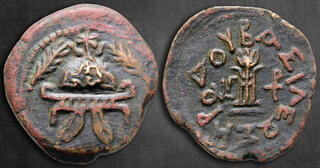| Savoca Numismatik GmbH & Co. KG > Online Auction 193 | Silver | Auction date: 28 January 2024 |
| Lot number: 88 Price realized: 650 EUR (Approx. 704 USD) Note: Prices do not include buyer's fees. | Show similar lots on CoinArchives Find similar lots in upcoming auctions on |
| Lot description: Judaea. Samarian mint (Sebaste?). Herodians. Herod I (the Great) 40-4 BC. Dated RY 3 = 38/7 BC 8 Prutot Æ 23 mm, 6,81 g Ornate helmet with tall crest topped by star; palms flanking / ΒΑΣΙΛΕΩΣ ΗΡΟΔΟΥ, Tripod; LΓ (date) to left, monogram to right; all within wreath. Very Fine Hendin 1169; RPC I 4901; HGC 10, 651; Meshorer 44. Herod the Great, a Roman-appointed Jewish king is known for transformative building projects in Judea, notably the reconstruction of the Second Temple. Born in Idumea, he rose to power through Roman connections, becoming Galilee's governor around 47 BC and later appointed King of the Jews by the Roman Senate in 40 BC. Herod's rule ended Hasmonean autonomy, but faced internal challenges, including conflicts with the Hasmoneans and navigating Roman power struggles. Herod's reign marked a shift in Judea's history, featuring grand construction like the Temple Mount expansion and fortresses such as Masada. Despite these achievements, discontent grew due to heavy taxation and clashes with Jewish traditions. Accusations of insensitivity, like placing a golden eagle at the Temple entrance, led to opposition from religious sects. Herod's legacy includes controversies, such as executing family members, including his wife Mariamne I. The Massacre of the Innocents, narrated in the Gospel of Matthew, adds a religious dimension, although its historicity is debated. Despite architectural accomplishments, Herod's death in 4 BC, marked by a painful illness, brought internal strife, reflecting the delicate balance between Roman influence, Herod's governance, and the aspirations of Judea's populace. Starting price: 50 EUR |  |


